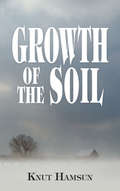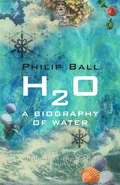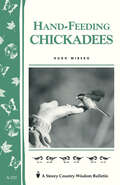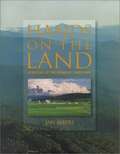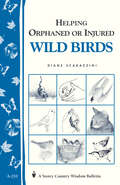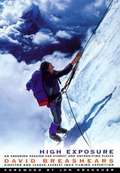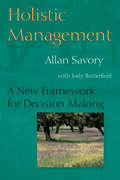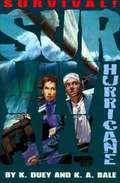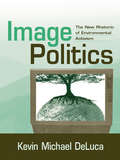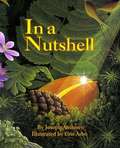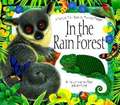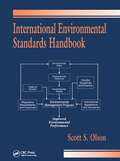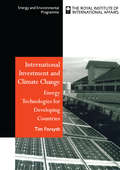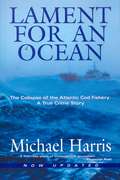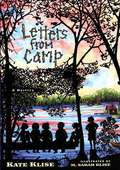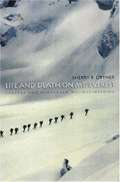- Table View
- List View
Growing Greener: Putting Conservation Into Local Plans And Ordinances
by Randall G. ArendtGrowing Greener is an illustrated workbook that presents a new look at designing subdivisions while preserving green space and creating open space networks. Randall Arendt explains how to design residential developments that maximize land conservation without reducing overall building density, thus avoiding the political and legal problems often associated with "down-zoning."Arendt offers a three-pronged strategy for shaping growth around a community's natural and cultural features, demonstrating ways of establishing or modifying the municipal comprehensive plan, zoning ordinance, and subdivision ordinance to include a strong conservation focus. Open space protection becomes the central organizing principle for new residential development, and the open space that is protected is laid out to form an interconnected system of protected lands across a community.Growing Greener builds upon and expands the basic ideas presented in Arendt's Conservation Design for Subdivisions, broadening the scope to include more detailed sections on the comprehensive planning process and information on how zoning ordinances can be updated to incorporate the concept of conservation design. It is the first practical publication to explain in detail how resource-conserving development techniques can be put into practice by municipal officials, residential developers, and site designers, and it offers a simple and straightforward approach to balancing opportunities for developers and conservationists.
Growth of the Soil (Twelve-point Series)
by Knut Hamsun W. W. WorsterA grand, sweeping saga of sacrifice and struggle, this epic tale recaptures the world of Norwegian homesteaders at the turn of the twentieth century. Isak and Inger, an idealistic young couple, reject modern society to raise their family on a back country farm. Isak's embrace of outdoor life reflects author Knut Hamsun's attitude of rugged individualism and his back-to-nature philosophy. Rich in symbolism, this moving tale of peasant life and the search for spiritual fulfillment in nature continues to resonate with modern readers. First published in Norwegian in 1917, Growth of the Soil created an international sensation and led to the author's 1920 Nobel Prize in Literature.
H2O: A Biography of Water
by Philip BallThe brilliantly told and gripping story of the most familiar - yet, amazingly, still poorly understood - substance in the universe: Water.The extent to which water remains a scientific mystery is extraordinary, despite its prevalence and central importance on Earth. Whether one considers its role in biology, its place in the physical world (where it refuses to obey the usual rules of liquids) or its deceptively simple structure, there is still no complete answer to the question: what is water? Philip Ball's book explains what, exactly, we do and do not know about the strange character of this most essential and ubiquitous of substances.H20 begins by transporting its readers back to the Big Bang and the formation of galaxies to witness the birth of water's constituent elements: hydrogen and oxygen. It then explains how the primeval oceans were formed four billion years ago; where water is to be found on other planets; why ice floats when most solids sink; why, despite being highly corrosive, water is good for us; why there are at least fifteen kinds of ice and perhaps two kinds of liquid water; how scientists have consistently misunderstood water for centuries; and why wars have been waged over it.Philip Ball's gloriously offbeat and intelligent book conducts us on a journey through the history of science, folklore, the wilder scientific fringes, cutting-edge physics, biology and ecology, to give a fascinating new perspective on life and the substance that sustains it. After reading this book, drinking a glass of water will never be the same again.
Hand-Feeding Chickadees: Storey's Country Wisdom Bulletin A-211 (Storey Country Wisdom Bulletin Ser.)
by Hugh WibergSince 1973, Storey's Country Wisdom Bulletins have offered practical, hands-on instructions designed to help readers master dozens of country living skills quickly and easily. There are now more than 170 titles in this series, and their remarkable popularity reflects the common desire of country and city dwellers alike to cultivate personal independence in everyday life.
Hands on the Land: A History of the Vermont Landscape
by Jan AlbersWinner of the annual Fred B. Kniffen Book Award presented by the Pioneer America Society (PAS). This award is given to the best new book published about the North American cultural landscape. Winner of a Vermont Book Professionals Association Milestone Award 2000, Winner of the National Arbor Day Foundation's 2001 Media Award and Winner of SPNEA's Book Prize for the year 2000 presented by the Society for the Preservation of New England Antiquities (SPNEA). This award is given to the book that best advances the understanding of the architecture, landscape and material culture of New England and the United States from the seventeenth century to the present published in 2000. In this book Jan Albers examines the history--natural, environmental, social, and ultimately human--of one of America's most cherished landscapes: Vermont. Albers shows how Vermont has come to stand for the ideal of unspoiled rural community, examining both the basis of the state's pastoral image and the equally real toll taken by the pressure of human hands on the land. She begins with the relatively light touch of Vermont's Native Americans, then shows how European settlers--armed with a conviction that their claim to the land was "a God-given right"--shaped the landscape both to meet economic needs and to satisfy philosophical beliefs. The often turbulent result: a conflict between practical requirements and romantic ideals that has persisted to this day. Making lively use of contemporary accounts, advertisements, maps, landscape paintings, and vintage photographs, Albers delves into the stories and personalities behind the development of a succession of Vermont landscapes. She observes the growth of communities from tiny settlements to picturesque villages to bustling cities; traces the development of agriculture, forestry, mining, industry, and the influence of burgeoning technology; and proceeds to the growth of environmental consciousness, aided by both private initiative and governmental regulation. She reveals how as community strengthens, so does responsible stewardship of the land. Albers shows that like any landscape, the Vermont landscape reflects the human decisions that have been made about it--and that the more a community understands about how such decisions have been made, the better will be its future decisions.
Hawaiian Legends of Volcanoes
by W. D. WesterveltInterspersed with legends of the fire goddess Pele, the lightning goddess Hiiaka, and others, are nuggets of related geological and historical information. First published in 1916, this book has a four-page appendix and notes on Polynesian language.
Helping Orphaned or Injured Wild Birds: Storey's Country Wisdom Bulletin A-210 (Storey Country Wisdom Bulletin Ser.)
by Diane ScarazziniTo Help or Not to Help? When faced with an injured bird or orphaned nestling, most people want to help but don’t know how – and also fear doing more harm than good. In fact, many wild birds that appear to be in trouble don’t need assistance at all. How do you know whether a bird needs help? How do you know what sort of help the bird needs? In Helping Orphaned or Injured Wild Birds, you’ll find all the information you need on when and how to assist all kinds of birds, from wrens to raptors. You’ll learn how to: Identify whether a bird needs rescuingHelp a baby bird that’s fallen from its nestIdentify the age and species of an injured of orphaned birdPrepare emergency rations for a baby birdAdminister basic bird first-aid Locate a professional wildlife rehabilitator
Herbal Homekeeping
by Sandy MaineIf you're alergic to the abrasive cleaners on the market today, or if you just want to be more environmentally concious, chedk out this book on how to make your own all-natural cleaners for the home, garage, and barn.
High Exposure: An Enduring Passion for Everest and Unforgiving Places
by Jon Krakauer David F. BreashearsFor generations of resolute adventurers, from George Mallory to Sir Edmund Hillary, Tenzing Norgay to Jon Krakauer, Mount Everest and the world's greatest peaks have provided the ultimate testing ground. As the world's fascination with mountaineering reaches a fever pitch, the question remains: Why climb? In High Exposure, elite mountaineer and acclaimed filmmaker David Breashears answers with an intimate and captivating look at his life. Breashears's passion for climbing began on the cliffs of Boulder, Colorado--and nearly ended on the south side of Everest in 1996.
Holistic Management: A New Framework for Decision Making
by Jody Butterfield Allan SavoryHolistic Management has been practiced by thousands of people around the world to profitably restore and promote the health of their land through practices that mimic nature, and by many others who have sought a more rewarding personal or family life. This book is an essential handbook for anyone involved with land management and stewardship.
Hornbills (Nature's Children)
by Lorien KiteHow many different kinds of hornbills are there? How big is a hornbill? Where do hornbills live? Find the answers to these questions, and learn much more about the physical characteristics, behavior, habitat, and lives of hornbills.
Houghton Mifflin Discovery Works: Earth's Water
by Silver Burdett GinnWhere are sources of fresh water found? Think about where the water you use every day comes from. Is it brought by pipes from a faraway reservoir like the one shown? Does it come from a well drilled deep in the ground? Or does it come from some other source? What things in water can be harmful? Building a model of a water-filtering system will help you investigate how water that is dirty and unsafe is made clean and safe for drinking.
Hurricane: New Bedford, Massachusetts, 1784 (Survival!)
by Kathleen Duey Karen A. BaleDuring almost four years at sea with her whaling captain father, thirteen-year-old Rebecca finds life both boring and difficult--especially when the ship is nearly sunk by a hurricane.
Image Politics: The New Rhetoric of Environmental Activism (Revisioning Rhetoric Ser.)
by Kevin Michael DeLucaThis exceptional volume examines “image events” as a rhetorical tactic utilized by environmental activists. Author Kevin Michael DeLuca analyzes widely televised environmentalist actions in depth to illustrate how the image event fulfills fundamental rhetorical functions in constructing and transforming identities, discourses, communities, cultures, and world views. Image Politics also exhibits how such events create opportunities for a politics that does not rely on centralized leadership or universal metanarratives. The book presents a rhetoric of the visual for our mediated age as it illuminates new political possibilities currently enacted by radical environmental groups. Chapters in the volume cover key areas of environmental activism such as:*The rhetoric of social movements;*Imaging social movements;*Environmental justice groups; and*Participatory democracy. This book is of interest to scholars and students of rhetorical theory, media and communication theory, visual theory, environmental studies, social change movements, and political theory. It will also appeal to others interested in ecology, radical environmental politics, and activism, and is an excellent supplemental text in advanced undergraduate and graduate level courses in these areas.
In A Nutshell (Sharing Nature With Children)
by Joseph AnthonyAn acorn grows into a mighty oak, helps sustain other life, and eventually dies and continues to give life to others.
In the Rain Forest: A Touch-and-Feel Adventure
by Maurice PledgerWith many different textures and sights, visit the rainforest. Chameleons, hummingbirds, parrots, frogs and more spread over the pages to take you deep in the rainforest. These books feature interactive touch and feel pages and precious stories that will stimulate children's curiosity and make learning about the natural world an entertaining experience. Endearing animal characters and beautifully illustrated, nature-inspired settings encourage youngsters to ask for these books time and time again.
International Environmental Standards Handbook
by Scott S. OlsonLack of knowledge about, and noncompliance with, international standards can result in loss of sales and partnership opportunities as well as possible legal action. The International Environmental Standards Handbook provides the necessary historical background to understand the current status of international environmental standards. It contains copies of available treaties and provides coverage of laws and standards. The book offers strategies for designing and implementing environmental systems that will be internationally accepted. It includes a list of information sources and a directory of international environmental organizations.
International Investment and Climate Change: Energy Technologies for Developing Countries
by Timothy ForsythThis study, based on fieldwork and case studies of southeast Asian countries shows how privatization, investment and new energy technologies can be integrated to combat climate change and provide the maximum return for investors. The author explains what incentives and regulatory structures are needed that do not damage local competitiveness. Asserting that technology transfer is fundamental to effective policies for climate change and for economic development, the text examines how the benefits can be maximized.
International Trade and Climate Change Policies
by Duncan Brack with Michael Grubb and Craig WindramFocusing on the likely impacts on trade of the UN Framework Convention on Climate Change and the Kyoto Protocol, this book examines the actual and potential conflicts between whether liberalization of trade undermines the efforts of industrialised countries to mitigate climate change. It will be essential reading for environmental economists and those engaged in international environmental relations and policy.
Keeper Of The Swamp
by Ann GarrettAboy and his ailing grandfather pole a small boat out into the Louisiana bayou. Suddenly, they spot Boots, a female alligator the grandfather saved from poachers years ago. <P><P>How will the boy face the danger in learning to take care of this wild creature? Strikingly illustrated with artwork that combines oil painting and computer imaging, Keeper of the Swamp is a scary and satisfying tale that carries a strong environmental message.
Komodo Dragons (Nature's Children)
by Geoff MillerCan Komodo dragons breathe fire? How many teeth do Komodo dragons have? What do young Komodo dragons look like? Find the answers to these questions, and learn much more about the physical characteristics, behavior, habitat, and lives of Komodo dragons. Other books in this series are available in this library.
Lament for an Ocean: The Collapse of the Atlantic Cod Fishery
by Michael HarrisThe northern cod have been almost wiped out. Once the most plentiful fish on the Grand Banks off the coast of Newfoundland, the cod is now on the brink of extinction, and tens of thousands of people in Atlantic Canada have been left without work by a 1992 moratorium on fishing the stock. Today, the Pacific salmon stocks are in similar trouble – victims of the same blind, stupid greed. Angry, accusatory fingers have been pointed at various possible culprits for the collapse of the cod – at the Spanish and Portuguese, who for hundreds of years sent ever-bigger fleets to the Grand Banks; at the factory-freezer trawlers, which “vacuumed” the ocean floor for the prized fish; at those inshore fishermen who circumvented the rules governing the fishery; at the federal Department of Fisheries and Oceans, which is responsible for managing the fishery; at the harp seal, the cod’s competitor for food, whose numbers have exploded in recent years; even at Nature, for lowering the temperature of the ocean. InLament for an Ocean,the award-winning true-crime writer Michael Harris investigates the real causes of the most wanton destruction of a natural resource in North American history since the buffalo were wiped off the face of the prairies. The story he carefully unfolds is the sorry tale of how, despite the repeated and urgent warnings of ocean scientists, the northern cod was ruthlessly exploited.
Letters from Camp
by Kate KliseTo the parents of the warring siblings who attend Camp Happy Harmony, the camp seems a godsend. But after they've been there a while, the campers themselves think otherwise. To them, the six middle-aged Harmony siblings who run the camp seem a little "inharmonious." Soon the campers are deep into finding out just what the dastardly Harmonys have in store for them.
Life and Death on Mt. Everest: Sherpas and Himalayan Mountaineering
by Sherry B. OrtnerThe Sherpas were dead, two more victims of an attempt to scale Mt. Everest. Members of a French climbing expedition, sensitive perhaps about leaving the bodies where they could not be recovered, rolled them off a steep mountain face. One body, however, crashed to a stop near Sherpas on a separate expedition far below. They stared at the frozen corpse, stunned. They said nothing, but an American climber observing the scene interpreted their thoughts: Nobody would throw the body of a white climber off Mt. Everest. For more than a century, climbers from around the world have journeyed to test themselves on Everest's treacherous slopes, enlisting the expert aid of the Sherpas who live in the area. Drawing on years of field research in the Himalayas, renowned anthropologist Sherry Ortner presents a compelling account of the evolving relationship between the mountaineers and the Sherpas, a relationship of mutual dependence and cultural conflict played out in an environment of mortal risk. Ortner explores this relationship partly through gripping accounts of expeditions--often in the climbers' own words--ranging from nineteenth-century forays by the British through the historic ascent of Hillary and Tenzing to the disasters described in Jon Krakauer's Into Thin Air. She reveals the climbers, or "sahibs," to use the Sherpas' phrase, as countercultural romantics, seeking to transcend the vulgarity and materialism of modernity through the rigor and beauty of mountaineering. She shows how climbers' behavior toward the Sherpas has ranged from kindness to cruelty, from cultural sensitivity to derision. Ortner traces the political and economic factors that led the Sherpas to join expeditions and examines the impact of climbing on their traditional culture, religion, and identity. She examines Sherpas' attitude toward death, the implications of the shared masculinity of Sherpas and sahibs, and the relationship between Sherpas and the increasing number of women climbers. Ortner also tackles debates about whether the Sherpas have been "spoiled" by mountaineering and whether climbing itself has been spoiled by commercialism.

